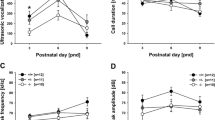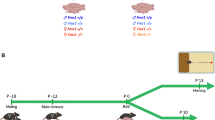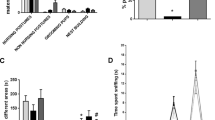Abstract
Mammalian attachment behaviors, such as crying, are essential for infant survival by receiving food, protection, and warmth from caregivers. Ultrasonic vocalization (USV) of infant rodents functions to promote maternal proximity. Impaired USV emission has been reported in mouse models of autism spectrum disorder, suggesting that USV is associated with higher brain function. In utero and lactational dioxin exposure is known to induce higher brain function abnormalities in adulthood; however, whether perinatal dioxin exposure affects behavior during infancy is unclear. Therefore, we studied the impact of dioxin exposure on USV emission in infant mice born to dams treated with 2,3,7,8-tetrachlorodibenzo-p-dioxin (TCDD; 0.6 or 3.0 µg/kg) on gestational day 12.5. On postnatal days 3–9, USVs of the offspring were recorded for 1 min using a microphone in a sound-attenuated chamber. The total USV and mean call durations in infant mice exposed to 3.0 µg/kg, but not 0.6 µg/kg, were shorter than those in the control mice. In addition, the percentages of complicated call types (i.e., chevron and wave) in mice exposed to 3.0 µg/kg were decreased. Dioxin-induced gene expression changes occurred in the brains of mice exposed to 3.0 µg/kg; however, body weight, motor activity, and vocal fold structure were not significantly affected. These results suggest that infant USV is a useful behavioral endpoint in developmental neurotoxicity assessment that may be used to evaluate effects of chemical exposure on the infant–caregiver interaction.







Similar content being viewed by others
References
Bowlby J (1958) The nature of the child’s tie to his mother. Int J Psychoanal 39:350–373
Bowlby J (1969) Attachment and loss, volume 1: attachment. Basic Books, Nwe York
Branchi I, Santucci D, Alleva E (2001) Ultrasonic vocalisation emitted by infant rodents: a tool for assessment of neurobehavioural development. Behav Brain Res 125(1–2):49–56
Chadman KK, Gong S, Scattoni ML, Boltuck SE, Gandhy SU, Heintz N, Crawley JN (2008) Minimal aberrant behavioral phenotypes of neuroligin-3 R451C knockin mice. Autism Res 1(3):147–158
Dastur FN, McGregor IS, Brown RE (1999) Dopaminergic modulation of rat pup ultrasonic vocalizations. Eur J Pharmacol 382(2):53–67
De Marco M, Halpern R, Barros HM (2005) Early behavioral effects of lead perinatal exposure in rat pups. Toxicology 211(1–2):49–58
Elsner J, Suter D, Alder S (1990) Microanalysis of ultrasound vocalizations of young rats: assessment of the behavioral teratogenicity of methylmercury. Neurotoxicol Teratol 12(1):7–14
Endo T, Kakeyama M, Uemura Y, Haijima A, Okuno H, Bito H, Tohyama C (2012) Executive function deficits and social-behavioral abnormality in mice exposed to a low dose of dioxin in utero and via lactation. PLoS One 7(12):e50741
Esposito G, Yoshida S, Ohnishi R, Tsuneoka Y, Rostagno Mdel C, Yokota S, Okabe S, Kamiya K, Hoshino M, Shimizu M, Venuti P, Kikusui T, Kato T, Kuroda KO (2013) Infant calming responses during maternal carrying in humans and mice. Curr Biol 23(9):739–745
Grandjean P, Landrigan PJ (2006) Developmental neurotoxicity of industrial chemicals. Lancet 368(9553):2167–2178
Grandjean P, Landrigan PJ (2014) Neurobehavioural effects of developmental toxicity. Lancet Neurol 13(3):330–338
Haijima A, Endo T, Zhang Y, Miyazaki W, Kakeyama M, Tohyama C (2010) In utero and lactational exposure to low doses of chlorinated and brominated dioxins induces deficits in the fear memory of male mice. Neurotoxicology 31(4):385–390
Hojo R, Stern S, Zareba G, Markowski VP, Cox C, Kost JT, Weiss B (2002) Sexually dimorphic behavioral responses to prenatal dioxin exposure. Environ Health Perspect 110(3):247–254
Hood DB, Woods L, Brown L, Johnson S, Ebner FF (2006) Gestational 2,3,7,8-tetrachlorodibenzo-p-dioxin exposure effects on sensory cortex function. Neurotoxicology 27(6):1032–1042
Jamain S, Radyushkin K, Hammerschmidt K, Granon S, Boretius S, Varoqueaux F, Ramanantsoa N, Gallego J, Ronnenberg A, Winter D, Frahm J, Fischer J, Bourgeron T, Ehrenreich H, Brose N (2008) Reduced social interaction and ultrasonic communication in a mouse model of monogenic heritable autism. Proc Natl Acad Sci USA 105(5):1710–1715
Kakeyama M, Sone H, Tohyama C (2001) Changes in expression of NMDA receptor subunit mRNA by perinatal exposure to dioxin. Neuroreport 12(18):4009–4012
Kakeyama M, Endo T, Zhang Y, Miyazaki W, Tohyama C (2014) Disruption of paired-associate learning in rat offspring perinatally exposed to dioxins. Arch Toxicol 88(3):789–798
Kehne JH, McCloskey TC, Baron BM, Chi EM, Harrison BL, Whitten JP, Palfreyman MG (1991) NMDA receptor complex antagonists have potential anxiolytic effects as measured with separation-induced ultrasonic vocalizations. Eur J Pharmacol 193(3):283–292
Kimura E, Kubo K, Matsuyoshi C, Benner S, Hosokawa M, Endo T, Ling W, Kohda M, Yokoyama K, Nakajima K, Kakeyama M, Tohyama C (2015) Developmental origin of abnormal dendritic growth in the mouse brain induced by in utero disruption of aryl hydrocarbon receptor signaling. Neurotoxicol Teratol 52(Pt A):42–50
Kimura E, Endo T, Yoshioka W, Ding Y, Ujita W, Kakeyama M, Tohyama C (2016) In utero and lactational dioxin exposure induces Sema3b and Sema3g gene expression in the developing mouse brain. Biochem Biophys Res Commun 476(2):108–113
Kuchiiwa S, Cheng SB, Nagatomo I, Akasaki Y, Uchida M, Tominaga M, Hashiguchi W, Kuchiiwa T (2002) In utero and lactational exposure to 2,3,7,8-tetrachlorodibenzo-p-dioxin decreases serotonin-immunoreactive neurons in raphe nuclei of male mouse offspring. Neurosci Lett 317(2):73–76
Mandal PK (2005) Dioxin: a review of its environmental effects and its aryl hydrocarbon receptor biology. J Comp Physiol B 175(4):221–230
Markowski VP, Zareba G, Stern S, Cox C, Weiss B (2001) Altered operant responding for motor reinforcement and the determination of benchmark doses following perinatal exposure to low-level 2,3,7,8-tetrachlorodibenzo-p-dioxin. Environ Health Perspect 109(6):621–627
Mimura J, Fujii-Kuriyama Y (2003) Functional role of AhR in the expression of toxic effects by TCDD. Biochim Biophys Acta 1619(3):263–268
Mitsui T, Sugiyama N, Maeda S, Tohyama C, Arita J (2006) Perinatal exposure to 2,3,7,8-tetrachlorodibenzo-p-dioxin suppresses contextual fear conditioning-accompanied activation of cyclic AMP response element-binding protein in the hippocampal CA1 region of male rats. Neurosci Lett 398(3):206–210
Mulero-Navarro S, Fernandez-Salguero PM (2016) New trends in aryl hydrocarbon receptor biology. Front Cell Dev Biol. 4:45
Nishijo M, Pham TT, Nguyen AT, Tran NN, Nakagawa H, Hoang LV, Tran AH, Morikawa Y, Ho MD, Kido T, Nguyen MN, Nguyen HM, Nishijo H (2014) 2,3,7,8-Tetrachlorodibenzo-p-dioxin in breast milk increases autistic traits of 3-year-old children in Vietnam. Mol Psychiatry 19(11):1220–1226
Noirot E (1972) Ultrasounds and maternal behavior in small rodents. Dev Psychobiol 5(4):371–387
OECD (2007) OECD guidelines for the testing of chemicals/Sect. 4: health effects.Test No. 426: developmental neurotoxicity study. http://www.oecd-ilibrary.org/environment/test-no-426-developmental-neurotoxicity-study_9789264067394-en. Accessed 26 Jan 2018
Patandin S, Lanting CI, Mulder PG, Boersma ER, Sauer PJ, Weisglas-Kuperus N (1999) Effects of environmental exposure to polychlorinated biphenyls and dioxins on cognitive abilities in Dutch children at 42 months of age. J Pediatr 134(1):33–41
Portfors CV (2007) Types and functions of ultrasonic vocalizations in laboratory rats and mice. J Am Assoc Lab Anim Sci 46(1):28–34
Radyushkin K, Hammerschmidt K, Boretius S, Varoqueaux F, El-Kordi A, Ronnenberg A, Winter D, Frahm J, Fischer J, Brose N, Ehrenreich H (2009) Neuroligin-3-deficient mice: model of a monogenic heritable form of autism with an olfactory deficit. Genes Brain Behav 8(4):416–425
Rankin J, Manning A (1993) Alterations to the pattern of ultrasonic calling after prenatal exposure to aluminium sulfate. Behav Neural Biol 59(2):136–142
Rogers SJ, Ozonoff S, Maslin-Cole C (1993) Developmental aspects of attachment behavior in young children with pervasive developmental disorders. J Am Acad Child Adolesc Psychiatry 32(6):1274–1282
Rutgers AH, Bakermans-Kranenburg MJ, van Ijzendoorn MH, van Berckelaer-Onnes IA (2004) Autism and attachment: a meta-analytic review. J Child Psychol Psychiatry 45(6):1123–1134
Sakakibara A, Hatanaka Y (2015) Neuronal polarization in the developing cerebral cortex. Front Neurosci 9:116
Schantz SL, Seo BW, Moshtaghian J, Peterson RE, Moore RW (1996) Effects of gestational and lactational exposure to TCDD or coplanar PCBs on spatial learning. Neurotoxicol Teratol 18(3):305–313
Spruston N (2008) Pyramidal neurons: dendritic structure and synaptic integration. Nat Rev Neurosci 9(3):206–221
Takahashi T, Okabe S, Broin PO, Nishi A, Ye K, Beckert MV, Izumi T, Machida A, Kang G, Abe S, Pena JL, Golden A, Kikusui T, Hiroi N (2016) Structure and function of neonatal social communication in a genetic mouse model of autism. Mol Psychiatry 21(9):1208–1214
Tanida T, Warita K, Ishihara K, Fukui S, Mitsuhashi T, Sugawara T, Tabuchi Y, Nanmori T, Qi WM, Inamoto T, Yokoyama T, Kitagawa H, Hoshi N (2009) Fetal and neonatal exposure to three typical environmental chemicals with different mechanisms of action: mixed exposure to phenol, phthalate, and dioxin cancels the effects of sole exposure on mouse midbrain dopaminergic nuclei. Toxicol Lett 189(1):40–47
Teague SJ, Gray KM, Tonge BJ, Newman LK (2017) Attachment in children with autism spectrum disorder: a systematic review. Res Autism Spect Disord 35:35–50
US EPA (1998) Health effects guidelines OPPTS 870.6300 developmental neurotoxicity study. https://nepis.epa.gov/Exe/ZyPDF.cgi/P100IRWO.PDF?Dockey=P100IRWO.PDF Accessed Jan 26 2018
Van den Berg M, Birnbaum L, Bosveld AT, Brunström B, Cook P, Feeley M, Giesy J, Hanberg A, Hasegawa R, Kennedy SW, Kubiak T, Larsen JC, van Leeuwen FX, Liem AK, Nolt C, Peterson RE, Poellinger L, Safe S, Schrenk D, Tillitt D, Tysklind M, Younes M, Waern F, Zacharewski T (1998) Toxic equivalency factors (TEFs) for PCBs, PCDDs, PCDFs for humans and wildlife. Environ Health Perspect 106(12):775–792
Venerosi A, Ricceri L, Scattoni ML, Calamandrei G (2009) Prenatal chlorpyrifos exposure alters motor behavior and ultrasonic vocalization in CD-1 mouse pups. Environ Health 8:12
Winslow JT, Insel TR (1991) Serotonergic modulation of the rat pup ultrasonic isolation call: studies with 5HT1 and 5HT2 subtype-selective agonists and antagonists. Psychopharmacology 105(4):513–520
Winslow JT, Insel TR, Trullas R, Skolnick P (1990) Rat pup isolation calls are reduced by functional antagonists of the NMDA receptor complex. Eur J Pharmacol 190(1–2):11–21
Winslow JT, Hearn EF, Ferguson J, Young LJ, Matzuk MM, Insel TR (2000) Infant vocalization, adult aggression, and fear behavior of an oxytocin null mutant mouse. Horm Behav 37(2):145–155
Wong RO, Ghosh A (2002) Activity-dependent regulation of dendritic growth and patterning. Nat Rev Neurosci 3(10):803–812
Acknowledgements
We are grateful to Ms. Junko Gorai and Dr. Masanobu Kohda for their excellent technical assistance. This work was supported in part by a grant from the JSPS Kakenhi (JP24221003 to C.T. and 17J07847 to E.K.).
Author information
Authors and Affiliations
Corresponding author
Ethics declarations
Conflict of interest
The authors declare no competing financial interests.
Rights and permissions
About this article
Cite this article
Kimura, E., Tohyama, C. Vocalization as a novel endpoint of atypical attachment behavior in 2,3,7,8-tetrachlorodibenzo-p-dioxin-exposed infant mice. Arch Toxicol 92, 1741–1749 (2018). https://doi.org/10.1007/s00204-018-2176-1
Received:
Accepted:
Published:
Issue Date:
DOI: https://doi.org/10.1007/s00204-018-2176-1




